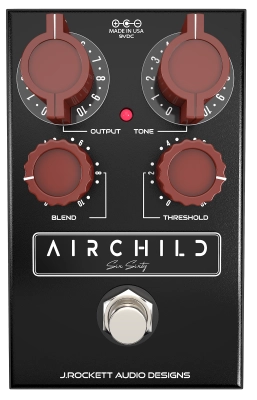J. Rockett Audio Designs Airchild Six Sixty Compressor Pedal
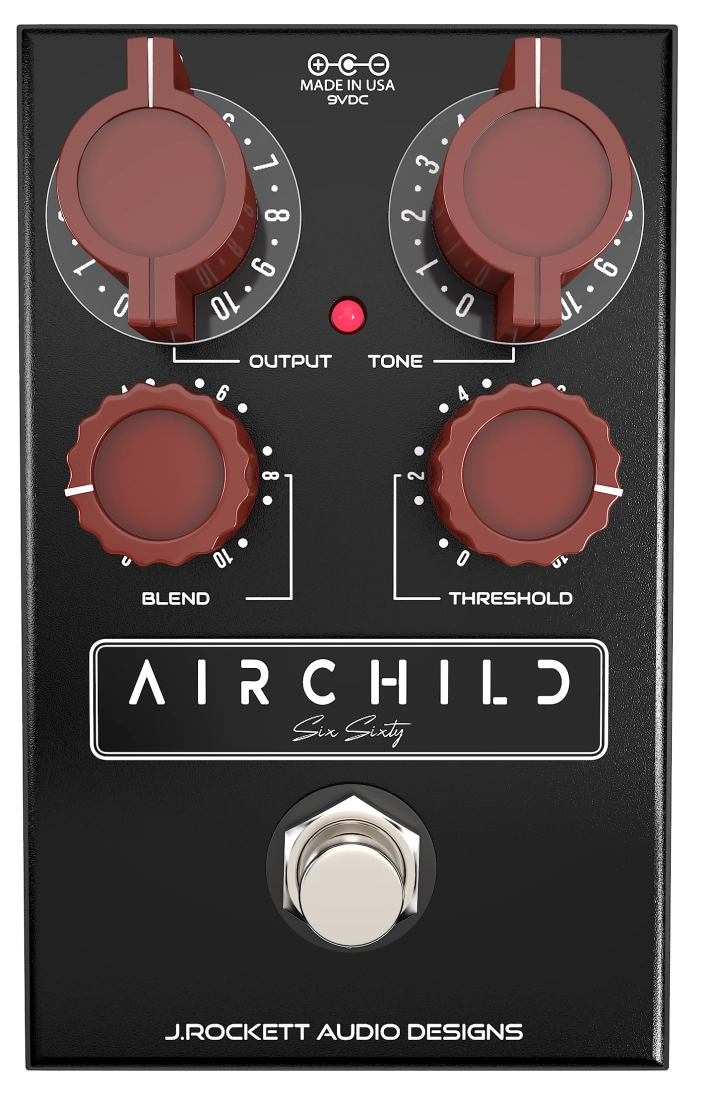
Additional Photos:
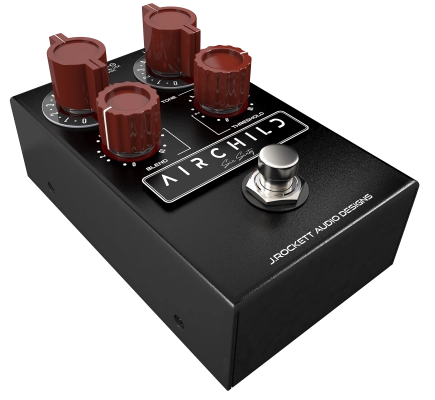
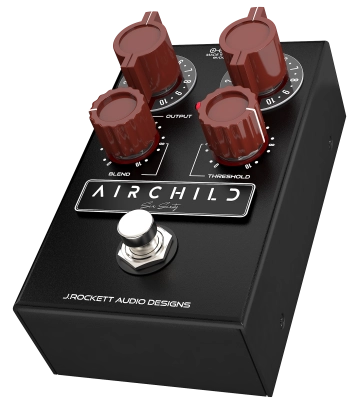
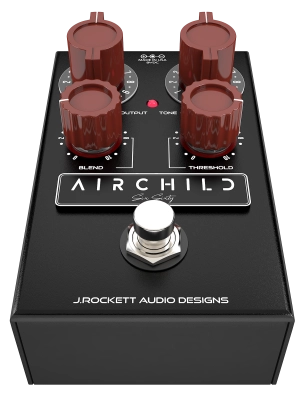

The typical iconic guitar compressor has created very recognizable tones throughout the history of music, especially Country music. That being said thry felt that there were already too many clones of that legendary circuit with few other variants available.
The typical Iconic circuit tends to crush the sound more like a limiter but has also cemented that sound into certain genres of music which is a great sound if so desired. J. Rockett wanted to make available a compressor that works like a studio compressor which enhances harmonic richness and evens out transients without crushing the entire spectrum. The Airchild Six Sixty simply makes you want to play more, it increases sustain without crushing your output, it imparts richness to your overall tone and adds feel to your playing. Their target tones were the slide tones of Lowell George and the singing lead/rhythm tones of Mark Knopfler.
History/Origins
The original Fairchild 660 Compressor was designed by Rein Narma, who had worked with Les Paul to build a recording mixer to use with Les Paul's Ampex 8-track. Les Paul asked Narma if he would build a compressor/limiter. Sherman Fairchild, who was friends with Les Paul, learned of the compressor and licensed Narma's compressor design, hiring Narma to be chief engineer at Fairchild Recording Equipment Corporation. The first 10 Fairchild 660's were built by Narma himself. The first unit was sold to Rudy Van Gelder who used it to cut lacquer masters for Blue Note Records and Vox Records. The second unit went to Olmsted Sound Studios in New York City and the third 660 built went to Mary Ford and Les Paul.
Design
The mono 660 and dual-channel 670 can function as a compressor with a ratio of 2 to 1 and a threshold of 5 db below normal program level, as a peak limiter with a compression ratio of 30 to 1 and a threshold of 10 db above normal program level, or can operate anywhere between those two extremes. Utilizing a single push-pull stage of amplification and an extremely high control voltage, the sound of the 660 and 670 is characterized by the complete absence of audible thumps, with extremely low distortion and noise. Both feature an extremely fast attack time that can produce the full limiting effect during the first 1/10,000 of a second. This extremely fast attack time is combined with six different variable release timing curves, three of those making the release time an automatic function of the amount of limiting used, making the 660 the first compressor/limiter to feature automatic variable release time.
The 660 has controls for input gain, threshold, and time constant. The dual-channel 670 has the added flexibility of being able to be used either as two independent limiters or as a vertical and lateral (sum and difference) component limiter. At the time of its introduction, the 670 was the only unit that could independently control both vertical and lateral with a minimum loss of separation.
Notable Users
Abbey Road Studios purchased 12 660s after staff engineer Peter Bown heard it during a visit to Capitol Records in America and used it on recording sessions for the Beatles, primarily for vocals. Beginning in 1966, Geoff Emerick began using the 660 on Ringo Starr's drum tracks as well as piano and guitar tracks. As of 2014, Abbey Road still had 8 of the original 660s purchased in the 1960s.
Compressors are probably the most misunderstood effect that also have incredible impact on the delivery of music. There is not a professional recording in history that does not have some sort of compression. Gain is a form of compression, even EQ is a form of compression.
A compressor is used to reduce a signal's dynamic range-that is, to reduce the difference in level between the loudest and quietest parts of an audio signal.
Compression is commonly used to attenuate loud transient peaks (e.g., when a singer suddenly belts out a high note or a guitar player digs in to a note with muscle) compression helps maintain a consistent level.
Compression essentially causes distortion in a signal, in that it changes the original sound of the signal through its processing. The compressor typically achieves this by emphasizing certain harmonics based on how the compressor is hitting the incoming signal. It is very common for guitar compressors to alter the inherent tone, mess with the top end and introduce noise in the process. It's the job of the designers to make that distortion feel transparent and dynamic to create the best-sounding performance one can achieve. Use your ears though!!
In compression, the dynamic range becomes narrower - the highest peaks and the quietest parts have fewer dB of level difference between them. In contrast, a compressor can also help support or bring to life soft notes as well. For guitar, compression helps with sustain and feel. Using compression in front of an amp with gain or a gain pedal essentially just adds more compression and is typically not very audible. A good compressor will help sustain notes without introducing noise or artifacts in an amp or pedal that has gain but typically works best in a clean amp to hear the effect. You will typically hear compression on country guitar, at least as an audible full throttle effect. Most players do not utilize this sound because a squished signal limits dynamics, however, if used correctly it can increase dynamics across the board. One of the best descriptions I have heard about compression is that it is the opposite of reverb. If you think about that it is true. Compression brings the full dynamic force forward in a balanced manner where Reverb creates space and distance.
1. OUTPUT - It may sound simple but output is a key feature to getting your compressor set properly. If you want to hear the full squish keep your output at unity or less (It is interactive with the threshold control so as you dial up the threshold your volume will increase so back off the output to hear the compression effect. If you push the output and hit the front of your amp hard it creates gain, therefore, compression gets lost. It will create sustain and harmonic richness but the compression effect will be harder to hear.
2. TONE - One of the biggest complaints about compressors is how they affect the EQ. A typical dynacomp will introduce noise and mess with the top end in an ugly way. The EQ on the AIRCHILD helps mitigate those typical issues and allows you to balance out the overall EQ to be natural. Turn the knob counter clockwise and it will introduce more bottom and less top, turn it clockwise and it will introduce more top and less bottom. This allows you to balance the EQ for your specific setup, every amp is different.
3. BLEND - Blend simply allows you to blend your dry signal with the compressed signal allowing for fine tuning so to speak.
4. THRESHOLD - Threshold in this configuration simply means more or less compression. All the way counter clockwise is fully off and all the way clockwise is fully compressed. You can then Taylor that to your preference by using the blend control to balance it out to your requirements. Please experiment with the threshold control and keep in mind how interactive it is with the output control. The more output the more gain so the effect will be less noticeable with a hotter output. Using compression is a fine art so use your ears and your inherent feel to dial it in to your taste.
5. POWER - 9V/DC negative tip only!!! 20mA Draw. (No internal battery option)
Q & A
Reviews

Protect your investment with the Long & McQuade Performance Warranty
A warranty can be a very important factor when making a buying decision. Because repairs can be very expensive in terms of parts and labour costs, manufacturers usually only provide one year limited warranties that generally only cover items that malfunction due to a manufacturer’s defect. With an important purchase such as a musical
instrument or piece of studio gear, however, many people want to have the peace of mind in knowing that their investment will be protected should the product no longer be performing at 100%.
Because of this, Long & McQuade provides our customers with a FREE one-year Performance Warranty on most of our products. The Long & McQuade Performance Warranty supplements the manufacturer’s warranty to ensure that our customers receive complete “no hassle” warranty coverage within their first year.
How does the Long & McQuade Performance Warranty differ from most manufacturers' warranties?
- Performance Guarantee: Normal wear and tear is covered, so your product will be performing as well as the day you purchased it for the entire duration of the coverage. Band and Orchestral Performance Warranty does not include replacing pads or cleaning for woodwind instruments, unless deemed necessary by our repair staff. Ultrasonic cleaning for brass instruments will be provided if deemed necessary by our repair staff, but is not routinely offered under the Performance Warranty.
- Product Replacement: If your product cannot be fixed or costs too much to fix, we will replace it with the equivalent model for no additional charge. If this is not possible, a full refund will be provided.
- No Lemon Policy: Your product will be replaced should the same problem occur multiple times.
- Convenient: Easy drop off and pick up of the product at any Long & McQuade location.
- Guitar Setup: Guitars purchased at Long & McQuade come with 1 free setup, to be redeemed within 1 year for new guitars and 90 days for used guitars.
- Loaners Available: A loaner product may be given while the product is being repaired.
- Power Surge Protection: Your product is covered even if damaged from a power surge.
- Accessory Coverage: Any peripheral devices or accessories that come with your product (i.e. foot pedal, case) are also covered.
- Commercial Use Coverage: Music and recording professionals who purchase gear for “heavy-use” commercial purposes will still be covered.
Long & McQuade reserves the right to restrict the purchase of additional years of Performance Warranty. Used products come with a 3-month Long & McQuade Performance Warranty. Some products (i.e. computers, software, cymbals and other items) are covered only by the manufacturer‘s warranty. Consumables (i.e. strings, reeds, drum sticks, batteries, tubes, cross faders) are excluded as they are designed to be replaced. Cosmetic Damage, Accidental Damage, or problems caused by Humidity or Temperature Issues are not covered. Speakers damaged by overpowering are generally not covered. Our coverage does not provide compensation for loss of use. As of June 2018 the Performance Warranty is no longer transferable. The warranty is only valid in Canada.
Purchasing additional years of coverage
Some manufacturers provide warranties for longer than 1 year; however, these are usually limited warranties that do not provide the same coverage as the Long & McQuade Performance Warranty. Customers interested in more complete and convenient (but not necessarily longer) coverage are still able to purchase additional years of the Performance Warranty.
If you are interested in receiving this coverage for longer than one year, you have the option of purchasing additional years of the Performance Warranty. The pricing is as follows:
- NEW products: Starting at 4% of the current new selling price to double the warranty from 1 year to 2 years. Starting at 4% for each additional year.
- USED products: Starting at 4% of the current new selling price to increase the warranty from 3 months to 1 year. Starting at 4% for each additional year.
- GUITARS: 4% of the current new selling price to double the warranty from 1 year to 2 years. 4% for each additional year. $45 maximum. An additional free setup is not included with additional purchased years of Performance Warranty.
- BAND and ORCHESTRAL instruments: 4% of the current new selling price to double the warranty from 1 year to 2 years. 4% for each additional year.




